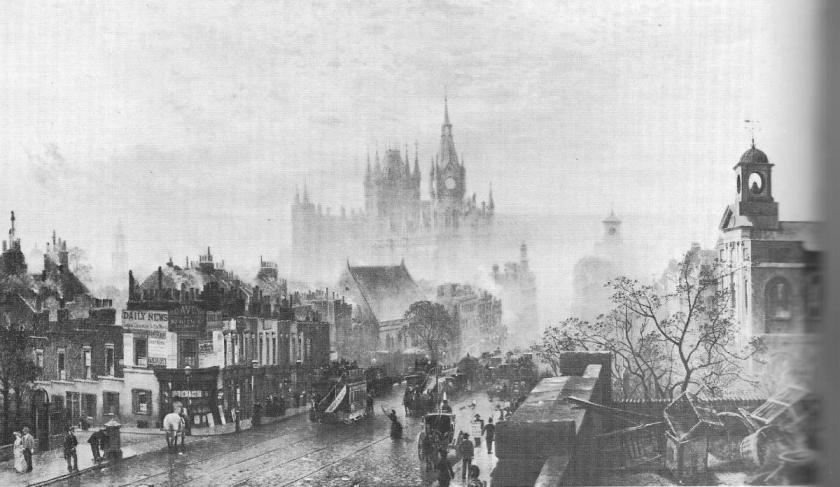
John O’Connor (1830-1889), Pentonville — looking west (1884)

Household Words
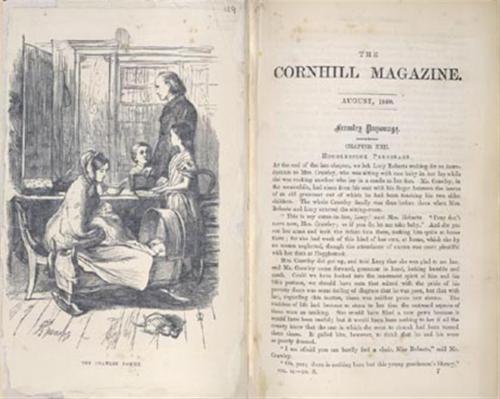
The Cornhill with an illustration of Framley Parsonage by John Everett Millais as frontispiece
For a Study Group at the Oscher LifeLong Learning Institute at American University
Literature and Language 641: Pivotal City and County Victorian Novels & Victorian Gothic
Day: Ten Monday early afternoons, 11:45 am to 1:15 pm
4801 Spring Valley Building, near American University main campus, Northwest, Washington DC
Dates: Classes start March 6th; last class May 8th, 2017.
Dr Ellen Moody
Description of Course
We’ll read 3 best-sellers: Gaskell’s North and South (1855), Trollope’s Framley Parsonage (1860), and Dickens’s “The Signalman” (1866) plus Margaret Oliphant’s ghost story, “The Library Window” (1896). Gaskell’s “Tale of Manchester Life,” published in Dickens’s highly politicized and socially concerned Household Words, is a radical graphic tale of the life of factory workers, based on a strike and time of near starvation and unmitigated depression, and by a woman. Trollope’s 4th Barsetshire concoction, commissioned by Thackeray at The Cornhill for its first series of issues made The Cornhill, which may be called the New Yorker of its day, enormously popular; Framley Parsonage was intensely as Downton Abbey: Gaskell said of it she wished he would go on writing it forever; she did not see why he should ever stop. FP, seen today also as a complacent pro-establishment book, is a Thackerayan ironic pleasure, wider ranging in its perspectives than is usually noted. Dickens’s short story, unrivaled as a psychological study over a response to machinery from an old world and gothic perspective was the Christmas tale his periodical, All the Year Round, is autobiographical, and was in 1976 adapted into a gem of a BBC film by Andrew Davies. Oliphant’s “Library Window” was serialized in Blackwood’s and is a self-reflexive account of authorship. We’ll explore how these fictions intersect with one another, mirror their shared era, and connect to our own.
Required Texts in the order we’ll read them:
Elizabeth Gaskell, North and South, ed, intro. Patricia Holman. 2003: rpt of Penguin 1995 ed. ISBN: 9780140434248
Anthony Trollope, Framley Parsonage, ed. David Skilton and Peter Miles. Penguin 1986. ISBN 0140432132
Charles Dickens, “The Signalman,” found in The Complete Ghost Stories of Charles Dickens, ed. Peter Hanning. New York: Franklin Watts, 1983. Contains A Christmas Carol and several other gems, plus has original illustrations with stories. It is online in at least 3 places: http://onlinebooks.library.upenn.edu/webbin/gutbook/lookup?num=1289
http://commapress.co.uk/resources/online-short-stories/the-signalman-charles-dickens
Margaret Oliphant’s “Library Window,” https://archive.org/details/Four_Stories_of_the_Seen_and_Unseen. Or from Blackwood’s the first publication: https://archive.org/stream/blackwoodsmagazi159edinuoft#page/n5/mode/2up

John Constable (1776-1837), Stoke-by-Nayland (1835/6)
Format: Study group meetings will be a mix of informal lecture and group discussion (essays mentioned will be sent by attachment or are on-line).
Mar 6th: In class: Introduction to course: the era, genres; shared themes. Introducing Gaskell: life & work; conflicts with her publisher Dickens
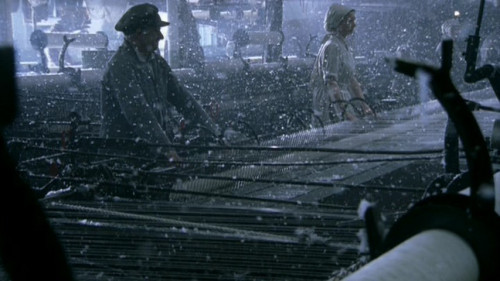
Medium range shot of Thornton’s cotton factory

Anna Maxwell Martin as Bessy Higgins (both from Sandy Welch’s North and South, BBC 2004)
Mar 13th: In class: Gaskell’s North and South, Chapters 1-17 (“Haste to the Wedding” through “What is a Strike?”
Mar 20th: In class: North and South, Chs 18-34 (“Like and Dislikes” through “False and True”. Beyond the novel, read for next time: Rosemarie Bodenheimer, North and South: A Permanent State of Change,” Nineteenth-Century Fiction, 34:3 (1979):281-301
Mar 27th: North and South, Chs 35-end (“Expiation” through “Pack Cloudes Away”); . Beyond the novel, for next time Michael D. Lewis, “Mutiny in the Public Sphere Debating Naval Power in Parliament, the Press, and Gaskell’s North and South, Victorian Review, 36:1 (2010):89-113.
Apr 3rd: We begin with clips from the BBC 2004 North and South (scripted by Sandy Welch) and discuss the film adaptation. Then Introducing Trollope: life & works; the Barsetshire series and The Cornhill; read for next time: Trollope’s Framley Parsonage, Chapters 1-15 (or Instalments 1-5, “Omnes Omnia bona dicere” to “Lady Luftons Ambassador.”
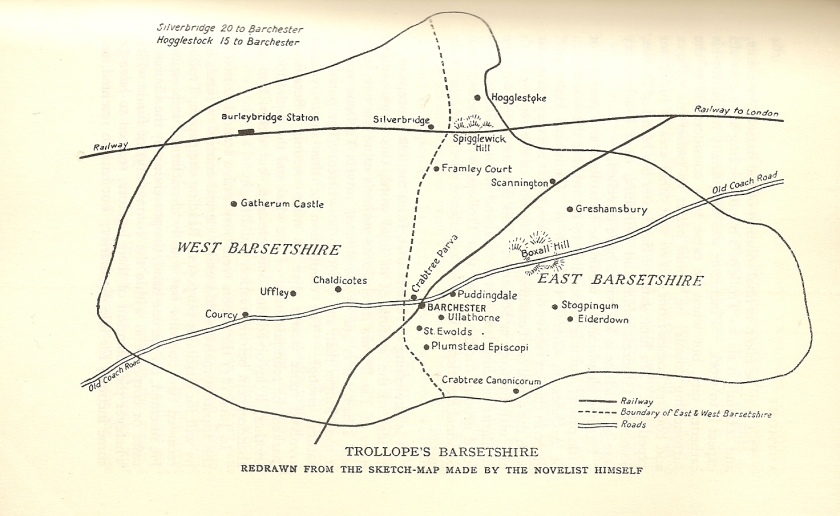
Michael Sadleir’s Barsetshire drawn by a sketch made by Trollope
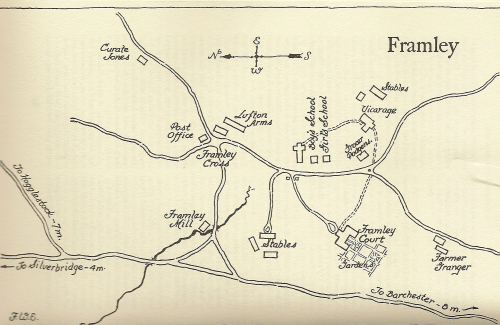
The Geroulds’ map of just Framley Parsonage
Apr 10th: Trollope’s Framley Parsonage, Instalments 1-5 (Chapters 1-15: “Omnes omnia bona dicere” to “Lady Lufton’s Ambassador”). For next time read Framley Parsonage, Instalments 6-11 (Chapters 16-33, “Mrs Podgens’ Baby” through “Consolation”); Andrew Maunderley, “Monitoring the Middle-Classes”: Intertextuality and Ideology in Trollope’s “Framley Parsonage and the Cornhill Magazine,” Victorian Periodicals Review (33:1, Cornhill Magazine II, Spring, 2000):44-64.
Apr 17th: Framley Parsonage, Instalments 6-11 (Chapters 16-33, “Mrs Podgens’ Baby” through “Consolation”). Read for next time Instalments 12-16 (Chapters 34-48, “Lady Lufton is taken by Suprise” to “How they all Married, had Two Children and Lived Happily Ever after.” Read also for next time, Stacey Margolis, Trollope for Americanists,” The Journal of Nineteenth-Century, 1:1 (2013):219-228; Mary Hamer, “Trollope’s First Serial Fiction,” The Review of English Studies, New Series, 26:102 (1975):154-170.
Apr 24th: Framley Parsonage, Instalments 12-16 (Chapters 34-48, “Lady Lufton is taken by Suprise” to “How they all Married, had Two Children and Lived Happily Ever after.” Full context for Trollope. Read for next time Dickens’s “The Signalman.” Read also Jill Matus, “Memory and Railway Disaster; The Dickensian Connection,” Victorian Studies 43:3 (Spring 2001):413-36
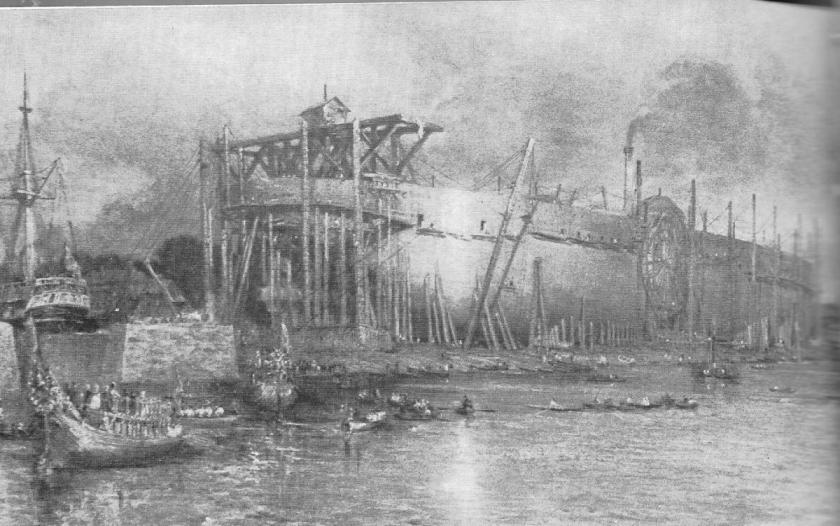
William Parrott (1813-69) The Great Eastern Under Construction at Millwall on the Isle of Dogs (1857)
May 1st: Introducing Dickens, Victorian gothic, the Christmas story; his life & work. For next time, watch YouTube of Signalman online (if you can); read for next time: Norris Pope, Dickens’s “The Signalman and Information Problems in the Railway Age,” Technology and Culture, 42:3 (July 2001):436-461′ Tamar Heller, “Women’s Reading and Writing in Margaret Oliphant’s ‘The Library Window=’,” Victorian Literature and Culture, 25:1 (1997):23-37
May 8th: Final discussion of all four texts, the mid-Victorian era, our authors.
Suggested supplementary (outside) reading (the assigned essays will be sent by attachment) and good sources:
Gerould, Winnifred and James. A Guide to Trollope: An Index of the characters and places and digests of the plots of all Trollope’s novels. Princeton UP, 1948.
Halperin, John. Trollope and Politics: A Study of the Pallisers and others. NY: Macmillan, 1977.
Hughes, Linda and Michael Lund. Victorian Publishing and Mrs Gaskell’s Work. Charlottesville: University Press of Virginia, 1999.
Kaplan, Fred. Dickens: A Biography. New York: Wm Morrow, 1988.
Nayder, Lillian. The Other Dickens: A life of Catherine Dickens. Ithaca: Cornell UP, 2011.
Overton, Bill. The Unofficial Trollope. NJ: Barnes & Noble, 1982.
Sadleir, Michael. Trollope: a commentary. 1961: rpt London: Constable, 1927.
Snow, C. P. Trollope: An Illustrated Biography. New York: New Amsterdam, 1975.
Steinbach, Susie L. Understanding the Victorians: Culture and Society in 19th Century Britain. London: Routledge, 2012.
Stoneman, Patsy. Elizabeth Gaskell. Bloomington: Indiana UP, 1987. Very good short life and works.
Uglow, Jenny. Elizabeth Gaskell: A Habit of Stories. New York: Farrar, Straus, Giroux, 1993. The best.
Williams, Merryn. Margaret Oliphant: A Critical Biography. London: St Martin’s Press, 1986.
Films:
The Signalman. Dir. Lawrence Gordeon Clark. Screenplay Andrew Davies. Producer: Rosemary Hill. Featuring Denholm Elliot and Bernard Lloyd. BBC, 1976.
Barchester Chronicles. A 7-part BBC mini-series, 1983. Dr. Gilles. Scripted Alan Plater. Featuring Donald Pleasance, Nigel Hawthorne, Alan Rickman, Eleanor Mawe, Barbara Flynn, Susan Hampshire, Geraldine McEwan, Clive Swift
Dr Thorne. A 3 part IVT mini-series, 2016. Dr Niall McCormick. Scripted Julian Fellowes. Featuring Tom Hollander, Ian McShame, Stephani Martini, Phoebe Nicholls, Richard McCabe, Rebecca Front.
North and South. Dir. Brian Perceval. Screenplay: Sandy Welch. Producer: Kate Bartlett. Featuring Richard Armitage, Daniela Denby-Ashe, Brendan Coyle, Anna Maxwell Martin, Sinead Cusack, Tim Piggott-Smith, Pauline Quirk, Lesley Manville. BBC, 2004.
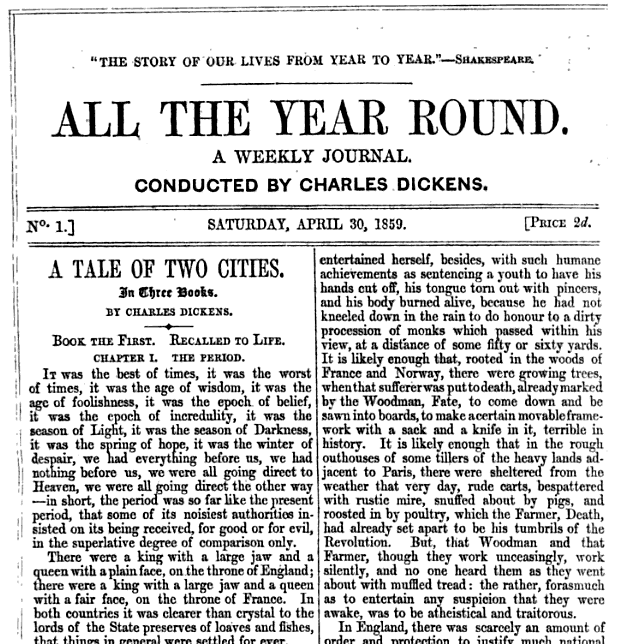
Beyond “The Signalman,” Dickens published much of his own fiction there: you see the 1st Instalment of A Tale of Two Cities
Ellen Moody

2 thoughts on “Pivotal City and County Victorian Novels: A spring syllabus”